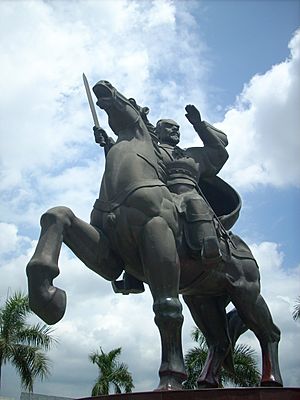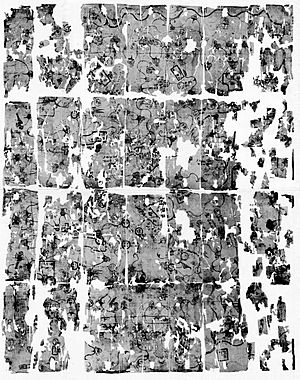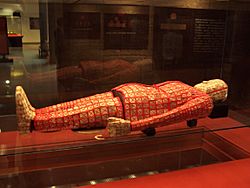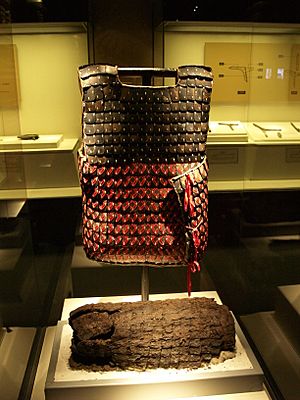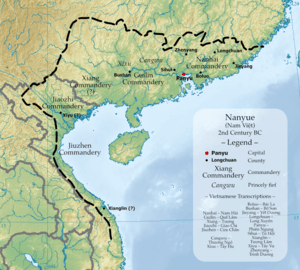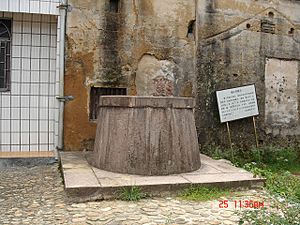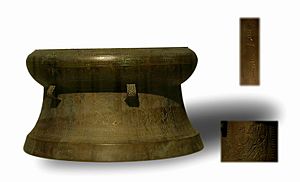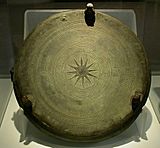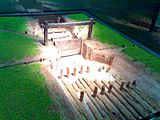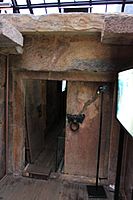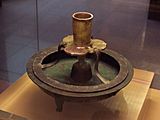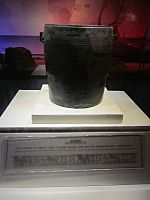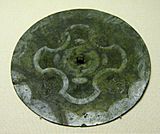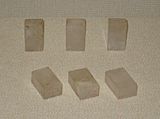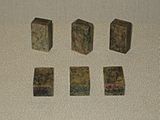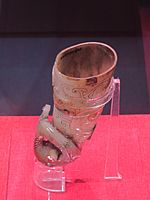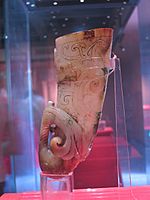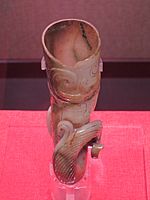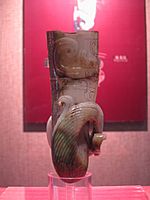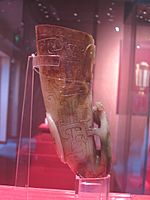Nanyue facts for kids
Quick facts for kids
Nanyue
|
|||||||||||||
|---|---|---|---|---|---|---|---|---|---|---|---|---|---|
| 204 BC–111 BC | |||||||||||||
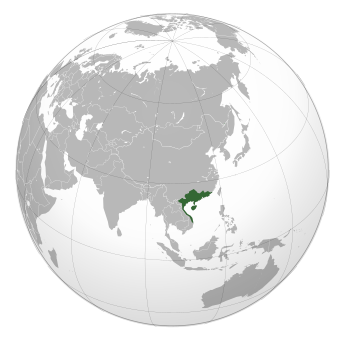
Location of Nanyue at its greatest extent
|
|||||||||||||
| Capital | Panyu | ||||||||||||
| Common languages | Old Chinese Old Yue languages |
||||||||||||
| Ethnic groups | Chinese (Huaxia people) Baiyue People |
||||||||||||
| Religion | Chinese folk religion local Shamanism |
||||||||||||
| Government | Monarchy | ||||||||||||
| Emperor or King | |||||||||||||
|
• 204–137 BC
|
Zhao Tuo | ||||||||||||
|
• 137–122 BC
|
Zhao Hu | ||||||||||||
|
• 122–113 BC
|
Zhao Yingqi | ||||||||||||
| Prime Minister | |||||||||||||
|
• 130–111 BC
|
Lü Jia | ||||||||||||
| History | |||||||||||||
|
• Qin "War of Pacification"
|
218 BC | ||||||||||||
|
• Establishment
|
204 BC | ||||||||||||
|
• First tribute to Han dynasty
|
196 BC | ||||||||||||
|
• Zhao Tuo accession
|
183 BC | ||||||||||||
|
• Conquest of Âu Lạc
|
179 BC | ||||||||||||
|
• Second tribute to Han dynasty
|
179 BC | ||||||||||||
| 111 BC | |||||||||||||
| Population | |||||||||||||
|
• 111 BC
|
1,302,805 | ||||||||||||
| Currency | Ban Liang | ||||||||||||
|
|||||||||||||
| Today part of | China Vietnam |
||||||||||||
| Nanyue | |||||||||||||||||||||||||||||||
|---|---|---|---|---|---|---|---|---|---|---|---|---|---|---|---|---|---|---|---|---|---|---|---|---|---|---|---|---|---|---|---|
| Chinese name | |||||||||||||||||||||||||||||||
| Chinese | 南越 | ||||||||||||||||||||||||||||||
| Hanyu Pinyin | Nányuè | ||||||||||||||||||||||||||||||
| Jyutping | Naam4 Jyut6 | ||||||||||||||||||||||||||||||
| Literal meaning | "Southern Yue" | ||||||||||||||||||||||||||||||
|
|||||||||||||||||||||||||||||||
| Vietnamese name | |||||||||||||||||||||||||||||||
| Vietnamese alphabet | Nam Việt | ||||||||||||||||||||||||||||||
| Chữ Hán | 南越 | ||||||||||||||||||||||||||||||
| Zhuang name | |||||||||||||||||||||||||||||||
| Zhuang | Namz Yied | ||||||||||||||||||||||||||||||
Nanyue (Chinese: 南越 or 南粵; Mandarin Pinyin: Nányuè; Jyutping: Naam4 Jyut6; literally "Southern Yue") was an ancient kingdom. It was ruled by Chinese kings from the Zhao family. This kingdom covered parts of modern-day China and Vietnam.
Nanyue was started by Zhao Tuo in 204 BC. He was a commander from the Qin dynasty. The kingdom formed after the Qin dynasty collapsed. It first included three main areas: Nanhai, Guilin, and Xiang.
In 196 BC, Zhao Tuo agreed to be loyal to the Emperor Gaozu of Han. Nanyue became a "vassal state," meaning it was under the Han dynasty but still had its own rule. However, around 183 BC, Nanyue and the Han dynasty had problems. Zhao Tuo started calling himself an emperor, showing he thought Nanyue was equal to the Han dynasty.
Later, in 179 BC, relations improved. Zhao Tuo again agreed to be a subject of the Han. But Nanyue still kept its independence. Zhao Tuo was called "Emperor" within Nanyue until he died. In 113 BC, the fourth king, Zhao Xing, wanted Nanyue to officially join the Han Empire. His prime minister, Lü Jia, strongly disagreed. Lü Jia then killed Zhao Xing and put his older brother, Zhao Jiande, on the throne. This led to a fight with the Han dynasty.
The next year, Emperor Wu of Han sent 100,000 soldiers to attack Nanyue. By the end of that year, the Han army had destroyed Nanyue. This brought the region under Han rule. The kingdom of Nanyue lasted for 93 years and had five kings.
Nanyue's existence helped the Lingnan region avoid the chaos. This chaos happened in northern China when the Qin dynasty fell. The kingdom was founded by leaders from central China. They brought Chinese ways of government and crafting skills to the southern people. They also introduced the Chinese language and writing system. Nanyue rulers wanted to bring together the different Hundred Yue tribes. They also encouraged Chinese people to move south. The rulers were open to mixing Yue and Han cultures.
In Vietnam, the Nanyue rulers are known as the Triệu dynasty. The name "Vietnam" comes from Nam Việt, which is the Vietnamese way of saying Nanyue.
Contents
History of Nanyue
A detailed history of Nanyue was written by Sima Qian. He was a historian from the Han dynasty. You can find most of it in his book Records of the Grand Historian. Another similar record is in the Book of Han.
How Nanyue Began
Qin's Southern Expansion (218 BC)
After Qin Shi Huang conquered six other Chinese kingdoms, he looked south. He sent General Tu Sui with 500,000 soldiers in 218 BC. Their goal was to attack the Hundred Yue tribes in the Lingnan region. The Qin army faced strong resistance. General Tu Sui was killed in a night attack by the Western Valley Yue.
The Qin emperor then chose General Zhao Tuo to lead the army. In 214 BC, Zhao Tuo and Ren Xiao led more troops. They completely defeated the Western Valley Yue. The Lingnan region came under Chinese control. The Qin court then set up three commanderies: Nanhai, Guilin, and Xiang. Ren Xiao became the Lieutenant of Nanhai. Zhao Tuo was made a magistrate in Longchuan.
The First Emperor died in 210 BC. Soon after, revolts broke out across China. The Yellow River region became very chaotic. Nanhai Lieutenant Ren Xiao became very sick. He called Zhao Tuo and told him to take over. Ren Xiao explained that the southern region was a good place to start a kingdom. He said it could fight against the warring groups in the north.
After Ren's death, Zhao Tuo secured the borders. He also removed Qin officials in Nanhai. He replaced them with his own trusted friends.
Conquest of Âu Lạc
The kingdom of Âu Lạc was south of Nanyue. It was mainly in the Red River delta. Âu Lạc recognized Nanyue's power. This was especially true because both kingdoms disliked the Han dynasty. Zhao Tuo strengthened his army, fearing a Han attack. However, when Nanyue's relations with the Han improved, Zhao Tuo attacked Âu Lạc in 179 BC. He successfully took over Âu Lạc.
Nanyue is Declared (204 BC)
In 206 BC, the Qin dynasty ended. The Yue people in Guilin and Xiang became independent again. In 204 BC, Zhao Tuo founded the Kingdom of Nanyue. He made Panyu its capital. He declared himself the Martial King of Nanyue (Chinese: 南越武王, Vietnamese: Nam Việt Vũ Vương).
Nanyue Under Zhao Tuo's Rule
Liu Bang started the Han dynasty in 202 BC. China was struggling after years of war. The Han court treated Nanyue carefully. In 196 BC, Emperor Gaozu sent Lu Jia to Nanyue. He wanted Zhao Tuo to pledge loyalty.
Lu Jia met Zhao Tuo, who was dressed in Yue clothing. Lu Jia told Zhao Tuo that he was Chinese and should follow Chinese customs. He also warned Zhao Tuo about the Han dynasty's strength. Lu Jia threatened to harm Zhao Tuo's family in China. Zhao Tuo then agreed to accept the Han Emperor's seal. He submitted to Han authority. Trade began between Nanyue and the Han's kingdom of Changsha. Nanyue was officially a Han subject, but it remained largely independent.
After Liu Bang died in 195 BC, his wife, Empress Lü Zhi, took power. She was angry with Zhao Tuo. She sent men to Zhao Tuo's hometown. They killed his family and damaged his family graves. Zhao Tuo believed this was because of false accusations. In revenge, he declared himself the Emperor of Nanyue. He attacked the Changsha kingdom and took some Han towns. Empress Lü sent a general to punish Zhao Tuo. But an illness spread among the Han soldiers. They had to retreat, giving Nanyue a victory.
Zhao Tuo then took over the neighboring state of Minyue. The kingdoms of Yelang and Tongshi also submitted to Nanyue.
In 179 BC, Liu Heng became the Han Emperor. He changed Empress Lü's policies. He was friendly towards Nanyue. He ordered officials to honor Zhao Tuo's ancestors. His prime minister suggested sending Lu Jia to Nanyue again. Lu Jia delivered a letter from the Emperor. It said Empress Lü's actions caused the problems. Zhao Tuo decided to submit to the Han again. He stopped using the title "Emperor" and went back to "King." Nanyue became a Han subject state. However, these changes were mostly on the surface. Zhao Tuo was still called "Emperor" within Nanyue.
Zhao Mo's Reign
In 137 BC, Zhao Tuo died at a very old age. His son had died before him. So, Zhao Tuo's grandson, Zhao Mo, became the king of Nanyue. In 135 BC, the king of Minyue attacked Nanyue's border towns. Zhao Mo asked Emperor Wu of Han for help. He called the Minyue attackers "rebels." The Emperor praised Zhao Mo's loyalty. He sent an army to help Nanyue. Before the army reached Minyue, the Minyue king was killed. His younger brother surrendered.
Emperor Wu sent an envoy to Nanyue to report Minyue's surrender. Zhao Mo sent his son, Zhao Yingqi, back with the envoy. Zhao Mo promised to visit the Han capital, Chang'an. However, one of his ministers advised him not to go. He feared Emperor Wu would not let him return. Zhao Mo then pretended to be sick. He never traveled to Chang'an.
Later, Zhao Mo became truly ill. He died around 122 BC.
Zhao Yingqi's Rule
Zhao Yingqi got permission from Emperor Wu to return to Nanyue. After Zhao Mo's death, Yingqi became the king. Before going to Chang'an, he had married a Yue woman. They had a son named Zhao Jiande. In Chang'an, he married a Han Chinese woman. They had a son named Zhao Xing. When he became king, he asked the Han Emperor to make his Chinese wife the Queen. He also asked for Zhao Xing to be the Crown Prince. This decision later caused problems for Nanyue. Zhao Yingqi was known as a harsh ruler. He died of illness around 113 BC.
Zhao Xing and Zhao Jiande
Zhao Xing became king after his father. His mother became the Queen Dowager. In 113 BC, Emperor Wu of Han sent an official to Nanyue. He wanted Zhao Xing and his mother to visit the Emperor in Chang'an. At this time, Zhao Xing was young. The Queen Dowager was new to Nanyue. So, Prime Minister Lü Jia held most of the power.
The Queen Dowager wanted Nanyue to fully submit to Han rule. She sent a message to Emperor Wu. She asked to join Han China and for borders to be removed. The Emperor agreed. He sent official seals to Nanyue's leaders. This showed that the Han court expected to control appointments. He also ended some harsh Yue punishments. King Zhao and the Queen Dowager began planning to go to Chang'an.
Prime Minister Lü Jia was much older. He had served since Zhao Xing's grandfather. His family was powerful in Nanyue. They were also related to the Zhao royal family. Lü Jia strongly opposed Nanyue becoming part of the Han dynasty. He criticized Zhao Xing many times, but was ignored. Lü Jia started planning a takeover. He pretended to be sick to avoid meeting the Han envoys.
When Emperor Wu heard about the situation, he sent 2,000 officials to Nanyue. Their goal was to take control from Lü Jia. In 112 BC, these men entered Nanyue. Lü Jia then carried out his plan. He told the people that Zhao Xing was too young. He said the Queen Dowager was a foreigner. He claimed she was plotting to give Nanyue to Han China. He said she would give away Nanyue's treasures and sell its people as slaves.
With the people's support, Lü Jia and his brother entered the palace. They killed Zhao Xing, the Queen Dowager, and all the Han envoys. Lü Jia made Zhao Jiande king. Zhao Jiande was Zhao Yingqi's oldest son by his Yue wife. Lü Jia quickly spread the news to other Nanyue rulers.
War and the End of Nanyue
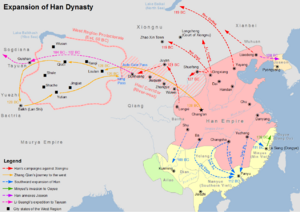
The 2,000 Han soldiers attacked towns near the border. The Yue people did not resist them. They gave them supplies and safe passage. The Han group got close to Panyu. But they were ambushed by Nanyue soldiers and destroyed. Lü Jia then sent a fake apology letter to the Han border. He also sent military troops. When Emperor Wu heard about the coup, he was furious. He ordered an army to attack Nanyue.
In the autumn of 111 BC, Emperor Wu sent 100,000 soldiers. They were divided into five groups to attack Nanyue. The Han forces advanced from different directions. One group was led by General Lu Bode. Another was led by Commander Yang Pu. Two other groups were led by Yue chieftains who had joined the Han. The fifth group was made of prisoners and soldiers from Yelang. They sailed down the Zangke River. A king from Dong'ou also sent 8,000 men to help the Han. But they secretly told Nanyue about the invasion.
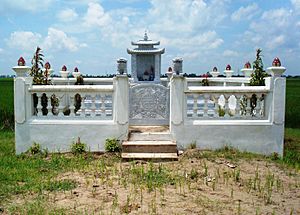
By winter, Yang Pu's group reached Panyu. They captured Nanyue's ships and supplies. They defeated the first Nanyue defenders. Then they waited for Lu Bode's group. Lu's soldiers were slow. So, Yang Pu attacked Panyu anyway. Lü Jia and Zhao Jiande were inside the city walls. Yang Pu set the city on fire. Lu Bode encouraged Nanyue soldiers to surrender. Many Panyu defenders joined Lu Bode's camp.
Lü Jia and Zhao Jiande realized Panyu was lost. They fled the city by boat. Han generals learned of their escape and sent men after them. Zhao Jiande was caught first. Lü Jia was captured in what is now northern Vietnam. Lü Jia was executed by the Han soldiers. His head was sent to the emperor.
After Panyu fell, Tây Vu Vương (a local captain) revolted. He was killed by his assistant. The other areas of Nanyue then surrendered to the Han dynasty. This ended Nanyue's 93 years as an independent kingdom. Emperor Wu was very happy about the news. He created new counties to celebrate the victory.
Geography and People
Borders of Nanyue
Nanyue first included the Qin commanderies of Nanhai, Guilin, and Xiang. After 179 BC, Zhao Tuo convinced Minyue, Yelang, and other areas to join Nanyue. But these areas were not fully controlled by Nanyue. After the Western Han dynasty defeated Nanyue, its land was split into seven commanderies.
It was once thought that the Qin conquest included northern Vietnam. And that Nanyue also controlled this area. However, some scholars now believe the Qin did not conquer Vietnam. They think Nanyue itself first brought Chinese rule there.
Administrative Divisions
Zhao Tuo used the Qin dynasty's system for organizing Nanyue. He kept Nanhai and Guilin commanderies as they were. He divided Xiang Commandery into Jiaozhi and Jiuzhen Commanderies. Nanhai covered most of modern Guangdong Province. It had several counties, and Zhao Tuo added two more.
Ethnic Groups
Most of Nanyue's people were Yue peoples. The Yue people were divided into many groups and tribes. The Nanyue lived in northern, eastern, and central Guangdong. A small group also lived in eastern Guangxi.
The Xi'ou lived in most of Guangxi and western Guangdong. Most of them lived along the Xun River. Their leaders were descendants of Yi-Xu-Song, a chieftain killed by the Qin army. When Nanyue was defeated, there were hundreds of thousands of Xi'ou people.
The Luoyue clans lived in parts of Guangxi, northern Vietnam, and Hainan. Their main areas were the Red River Delta in northern Vietnam. The Chinese name "Luo" was given to them. It means a white horse with a black mane. This name came from their slash-and-burn farming method.
Government and Military
How Nanyue Was Governed
Nanyue was founded by Zhao Tuo, a Chinese general. So, its government was similar to the Qin Empire's. Nanyue also adopted changes from the Han dynasty. But Nanyue was mostly independent. Its rulers made some unique systems.
Nanyue was a monarchy. The ruler was usually called "king." But the first two rulers, Zhao Tuo and Zhao Mo, were called "Emperor" within Nanyue. The kingdom had its own calendar system. This was like China's, based on the rulers' time in power. The next ruler was chosen by hereditary rule. The ruler's mother was the empress dowager. His wife was the empress or queen. His other wives were called "Madam." The royal family had the same titles as the Han dynasty Emperor's family.
Nanyue kept the Qin dynasty's Commandery-County system. But its leaders also gave land to their own princes and lords. This showed Nanyue's independence. Zhao Guang, a relative of Zhao Tuo, was made King of Cangwu. This area is now Wuzhou in Guangxi. Zhao Tuo also made a Yue chieftain King of Xixu. This allowed the Yue people there to rule themselves. This chieftain was a descendant of Yi-Xu-Song.
Nanyue's government had central and regional parts. The central government had a prime minister. He had military and administrative power. There were also scribes, censors, and guard commanders. Other officials handled food, music, and agriculture.
Nanyue also had other policies like the household registration system. This was an early form of counting the population. They also promoted the use of Chinese characters and Chinese weights and measures.
Nanyue's Military
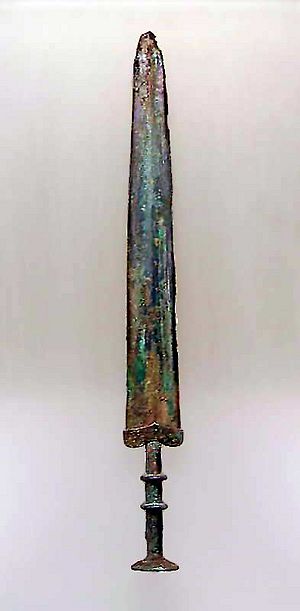
Nanyue's army was mostly made of Qin Chinese troops. These were the soldiers who invaded during the Qin dynasty. There were hundreds of thousands of them. After Nanyue was founded in 204 BC, some Yue people also joined the army. Nanyue's military officers had titles like General and Captain. These were similar to the Chinese system. The army had soldiers on foot, naval troops, and cavalry (soldiers on horseback).
Ethnic Policies
Nanyue continued many Qin policies about Han immigrants and local Yue people. Zhao Tuo actively encouraged the mixing of the two cultures. Han people held most leadership roles at first. But over time, more Yue people gained power in the government. Lü Jia, the last prime minister, was Yue. Over 70 of his relatives were officials. In some complex areas, Yue chieftains were given much independence.
Zhao Tuo encouraged Chinese immigrants to adopt Yue customs. Marriages between Han Chinese and Yue people became common. This even happened in the Zhao royal family. Many marriages between the Zhao family (Han Chinese) and the Lü family (Yue) were recorded. Zhao Jiande, the last king, was the son of King Zhao Yingqi and his Yue wife. The Chinese newcomers had a strong influence. But the mixing of cultures slowly increased over time.
Language in Nanyue
Han settlers and government officials spoke Old Chinese. The native Nanyue people likely spoke Ancient Yue. This language is now extinct. Some scholars think it was related to the modern Zhuang language. Others suggest they spoke Austroasiatic languages. It is possible that the Yue people spoke more than one language. Old Chinese in the region was probably influenced by Yue speech. And Yue speech was influenced by Chinese. Modern scholars have found many words borrowed between the languages.
Diplomacy and Relations
With the Western Han Dynasty
Nanyue's relationship with the Han dynasty changed over time. It went through periods of loyalty and then opposition. This continued until Nanyue was destroyed by the Han in 111 BC.
The first period of Nanyue being under the Han began in 196 BC. Zhao Tuo met a Han envoy and received a Han imperial seal. This made Zhao Tuo King of Nanyue. This period lasted 13 years. There was a lot of trade. Nanyue sent rare goods from the south. The Han court gave Nanyue iron tools, horses, and cattle. But the borders were always heavily guarded.
Nanyue's first period of fighting with the Han was from 183 BC to 179 BC. Trade stopped, and Zhao Tuo cut ties with the Han. Zhao Tuo openly called himself Emperor. He attacked the Changsha Kingdom, a Han state. Han troops were sent to fight Nanyue. Nanyue's armies stopped the Han advance. This earned them the respect and loyalty of Minyue and Yelang.
Nanyue's second period of being under the Han lasted from 179 BC to 112 BC. Zhao Tuo stopped using the title "Emperor." He declared loyalty to the Han Empire. But this was mostly for show. Zhao Tuo was still called emperor in Nanyue. The kingdom kept its independence. Zhao Tuo's four successors were not as strong. Nanyue slowly became more dependent on Han China. For example, the second king, Zhao Mo, asked Emperor Wu of Han for help against Minyue.
Nanyue's final period of fighting with Han China led to its destruction. At the time of Prime Minister Lü Jia's rebellion, Han China was strong. It had a growing economy and military success. It had defeated the Xiongnu tribes in the north. Nanyue was weak, and China was strong. This allowed Emperor Wu of Han to launch a powerful attack on Nanyue.
With Changsha
The Changsha Kingdom was a Han dynasty state. It covered most of modern Hunan Province. When Emperor Gaozu of Han made Wu Rui King of Changsha, he also gave him power over Nanhai, Xiang, and Guiling. This caused problems between Changsha and Nanyue from the start. The border between Han China and Nanyue was mainly the border with Changsha. So, it was always heavily guarded. Changsha had no independence. So, any Han policy towards Nanyue was also Changsha's policy.
With Minyue
Minyue was northeast of Nanyue. It was along China's southeast coast. It covered much of modern Fujian Province. The Minyue were defeated by the Qin dynasty in the 3rd century BC. Minyue ruler Wuzhu was removed. But Wuzhu supported Liu Bang after the Qin dynasty fell. So, the Han court made him King of Minyue again in 202 BC.
Relations between Nanyue and Minyue had three stages. The first was from 196 BC to 183 BC. Nanyue was loyal to the Han. The two kingdoms were fairly equal. The second stage was from 183 BC to 135 BC. Minyue submitted to Nanyue. This happened after Nanyue defeated the Han dynasty's first attack. The third stage began in 135 BC. King Wang Ying attacked a weakened Nanyue. This forced Zhao Mo to ask Han China for help. Minyue then submitted to the Han dynasty. This made Minyue and Nanyue equal again.
With the Yi Tribes
The southwestern Yi people lived west of Nanyue. They shared borders with Nanyue in areas like Yelang. Yelang was the largest state of the Yi people. It covered most of modern Guizhou and Yunnan Provinces. Some believe the ancient Yi were related to the Hundred Yue. This might explain the close ties between Yelang and Nanyue. After Nanyue first fought off the Han, almost all Yi tribes pledged loyalty to Nanyue. Most kept this loyalty until Nanyue fell in 111 BC. During Emperor Wu of Han's final attack on Nanyue, most Yi tribes refused to help. One chieftain even openly opposed the attack.
Monarchs of Nanyue
| Personal Name | Reign Period | Reigned From | Other Names | |||||||
|---|---|---|---|---|---|---|---|---|---|---|
| Name | Cantonese | Standard Mandarin | Zhuang | Vietnamese | Name | Cantonese | Standard Mandarin | Vietnamese | ||
| 趙佗 | ziu6 to4 | Zhào Tuó | Ciuq Doz | Triệu Đà | 武王 | mou5 wong4 | Wǔ Wáng | Vũ Vương | 203–137 BC | |
| 趙眜 | ziu6 mut6 | Zhào Mò | Ciuq Huz | Triệu Mạt | 文王 | man4 wong4 | Wén Wáng | Văn Vương | 137–122 BC | 趙胡 |
| 趙嬰齊 | ziu6 jing1 cai4 | Zhào Yīngqí | Ciuq Yinghcaez | Triệu Anh Tề | 明王 | ming4 wong4 | Míng Wáng | Minh Vương | 122–113 BC | |
| 趙興 | ziu6 hing1 | Zhào Xīng | Ciuq Hingh | Triệu Hưng | 哀王 | oi1 wong4 | Āi Wáng | Ai Vương | 113–112 BC | |
| 趙建德 | ziu6 gin3 dak1 | Zhào Jiàndé | Ciuq Gendwz | Triệu Kiến Đức | 陽王 | joeng4 wong4 | Yáng Wáng | Dương Vương | 112–111 BC | |
Archaeological Discoveries
The Nanyue Kingdom Palace Ruins are in Guangzhou. They cover 15,000 square meters. Excavated in 1995, they show remains of the ancient Nanyue palace. In 1996, the Chinese government listed it as a protected cultural site. Crescent-shaped ponds, Chinese gardens, and Qin dynasty architecture were found.
In 1983, the ancient tomb of the Nanyue King Wáng Mù was found in Guangzhou. In 1988, the Museum of the Mausoleum of the Nanyue King was built there. It displays over 1,000 artifacts. These include Chinese bronzes, jade, and metal pieces. In 1996, this site was also listed as a protected National Heritage Site.
A bronze seal was found in Thanh Hoa, northern Vietnam, in the 1930s. It says "Seal for Captain of Tu Pho County." It looks like seals from the second king of Nam Viet's tomb. So, it is believed to be an official seal of the Nam Viet Kingdom. Artifacts from the Dong Son culture of northern Vietnam were also found. These goods were buried with the second king of Nam Viet.
Nanyue in Vietnamese History
In Vietnam, the Nanyue rulers are called the Triệu dynasty. This is the Vietnamese way of saying the surname Chinese: 趙; pinyin: Zhào. Some older Vietnamese historians thought the Triệu dynasty was a true Vietnamese rule. But modern Vietnamese scholars usually see it as a foreign rule over Vietnam.
The name "Vietnam" comes from Nam Việt (Southern Việt). This is the Vietnamese pronunciation of Nanyue. However, some also think "Vietnam" came from a mix of other names. The Qing emperor Jiaqing changed the name to Việt Nam.
Some scholars believe ethnic Vietnamese people came from the ancient Yuè of northern Vietnam. However, the Vietnamese language is thought to have come from Laos and parts of Vietnam. It is not believed to have come from the Red River delta area. Some evidence suggests that Vietnamese language spread north to the Red River later.
Modern Western studies show that the Dong Son culture might have been Hlai people or Austronesians. The theory that Vietnamese language started in the Red River area is now largely rejected. This area is now thought to have been Tai-speaking. The area likely became Vietnamese-speaking around the tenth century. This was due to people moving from central Vietnam.
Zhao Tuo once wrote that he considered his native subjects "barbarians." Vietnamese historian Ngô Thì Sĩ (1726–1780) did not see Zhao Tuo as a Vietnamese leader. He said Zhao Tuo was based in Guangzhou. He only ruled the Hong River Delta indirectly.
There is evidence that Vietnamese leaders in the Red River Delta tried to create their own origin story. This was the legendary Hồng Bàng dynasty. It was based on old Chinese texts. These texts recorded the movements of Tai-speaking peoples in South China.
Culture and Art
Han and Yue cultures mixed in important ways. This is shown by artifacts found in King Zhao Mo's tomb in Guangzhou. The Nanyue tomb is very rich. It has many bronzes that show influences from Han, Chu, Yue, and Ordos regions.
Gallery
Jade Items from the Nanyue King's Mausoleum
See also
 In Spanish: Nanyue para niños
In Spanish: Nanyue para niños
- Triệu dynasty
- Zhao Tuo
- Panyu District
- Trọng Thủy
- Han–Nanyue War
- Âu Lạc
- Museum of the Mausoleum of the Nanyue King
- Tây Vu Vương
- Đông Sơn culture
- Minyue
- Yelang
- Baiyue





